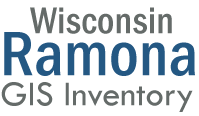There’s a new GIS data and land records inventory survey in town. And it’s called Ramona!
States, including Wisconsin, have begun populating a new online land information / GIS data survey called Ramona. While funny in name, the concepts behind the Ramona survey, created by the National States Geographic Information Council (NSGIC), are solid.
Much background work went into investigating how best to inventory and characterize GIS data programs across the country, while keeping respective state and local interests in mind. What has resulted is a customizable-by-state online survey tool that represents the natural evolution of (and was heavily influenced by) our former Wisconsin Land Information Program Survey.
I gave a presentation at the annual conference of the Wisconsin Land Information Association outlining some of the promised benefits that were beginning to take shape in other states working with Ramona – and encouraged those present to give it a try. Early results and feedback from Wisconsin users indicate the process is rather painless and has many benefits of an upgraded survey built on current technology.
Rather than narrate the benefits to you, I decided to come up with the top 10 current reasons to register, log-in and participate in the Wisconsin Ramona Survey… (drum roll please and with a Letterman-like clearing of the throat…)

#10: Communicating progress – Ramona will provide continuity with and connection to older survey results useful in characterizing 18 years of Wisconsin Land Information Program activity as proof of Program successes and impacts. But wait, this survey is not just for counties and their Land Information Officers – all data providers are asked to participate for 9 more highly-ranked reasons below.
#9: Federal partnering – Ramona will provide support for and potential prioritization in state/local partnership programs such as DNR’s participation as a pilot state in floodplain mapping maintenance through FEMA. Some pilot efforts elsewhere already rely on FEMA’s own imagery and elevation inventories… which will soon be auto-populated by Ramona. Other federal programs that could benefit just by knowing points of contact for GIS data include Census and the Department of Homeland Security, to name a few.
#8: Orthoimagery status – Ramona can provide an up-to-date imagery inventory for the new WLIA Orthoimagery Task Force, a group charged with developing a statewide orthoimagery program by 2010.
#7: Current parcel mapping inventory – Ramona can provide an up-to-date parcel data inventory as background information in support of multiple efforts aimed at analyzing parcel data modeling and integration at various levels for decision-making. This includes the new WLIA Parcel Data Modeling Task Force.
#6: Starter metadata – Ramona provides metadata templates for download. Because the survey creators looked at past state surveys as well as the metadata standard, what is collected here might be seen as inventory-level metadata you can download after filling out the survey.
All the benefits listed above can begin to flow primarily by filling out the core priority sections of the survey. But because the states had a say in how the survey operates, we now have an opportunity to add our own custom questions. The first slate of custom-questions for Wisconsin is intended to further connect current survey results to past WLIP surveys. This means, as times change, so will the survey; you can have confidence that this is not a flash-in-the-pan effort. Further, our office will be downloading and archiving full survey results so data is backed up off-site (from the Ramona server.)
#5: Statewide coordination – Ramona can provide inventory data for up-to-date analysis of statewide needs and priorities to support the work of a planned Wisconsin Geographic Information Coordination Council.
#4: Internal and external reporting – Results will become increasingly useful to contributors for purposes of 5-year land records plans, strategic planning, and reporting on your own status and progress.
#3: GIS directory for partners and customers – An additional feature and benefit of Ramona is an online GIS Directory (if one chooses to participate) which provides visibility not only to your peers but also data consumers. In another state’s early experience, they found that at least one quarter of registered participants were not data producers, but likely consumers who registered to find access paths to geographic information.
#2: The Wisconsin “Big Picture” – Our office is committed to pursuing custom analysis and reporting of survey results useful for answering not only snapshot-in-time questions, but also enabling analysis and reporting of progress over time. Ramona lets us track the long-term benefits of local investment in GIS data, and its path to integration for regional and state needs.
And #1: It’s about time – Frankly, getting a handle on our spatial assets is way over due. Ramona is not geared toward or controlled entirely by any one jurisdictional level (federal/state/local) and as such, each level will glean benefits not recognized by the others. But ultimately, Ramona is a place to compile the answers to questions you get all the time, thus allowing data consumers the ability to “self serve” for most basic information.
Let’s focus our efforts and inventorying and updating periodically in a way we can all learn from each other, and free up time to push our respective programs forward.
